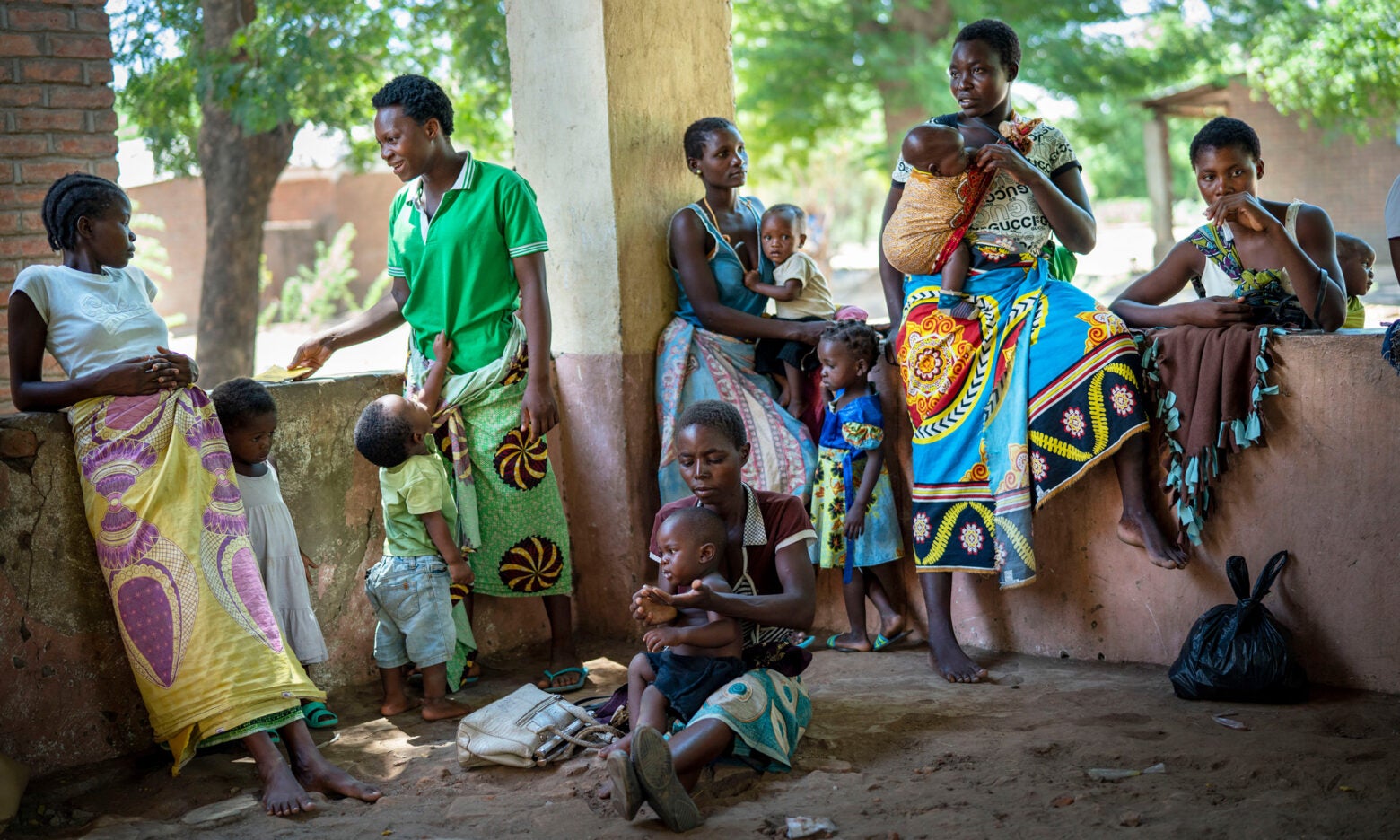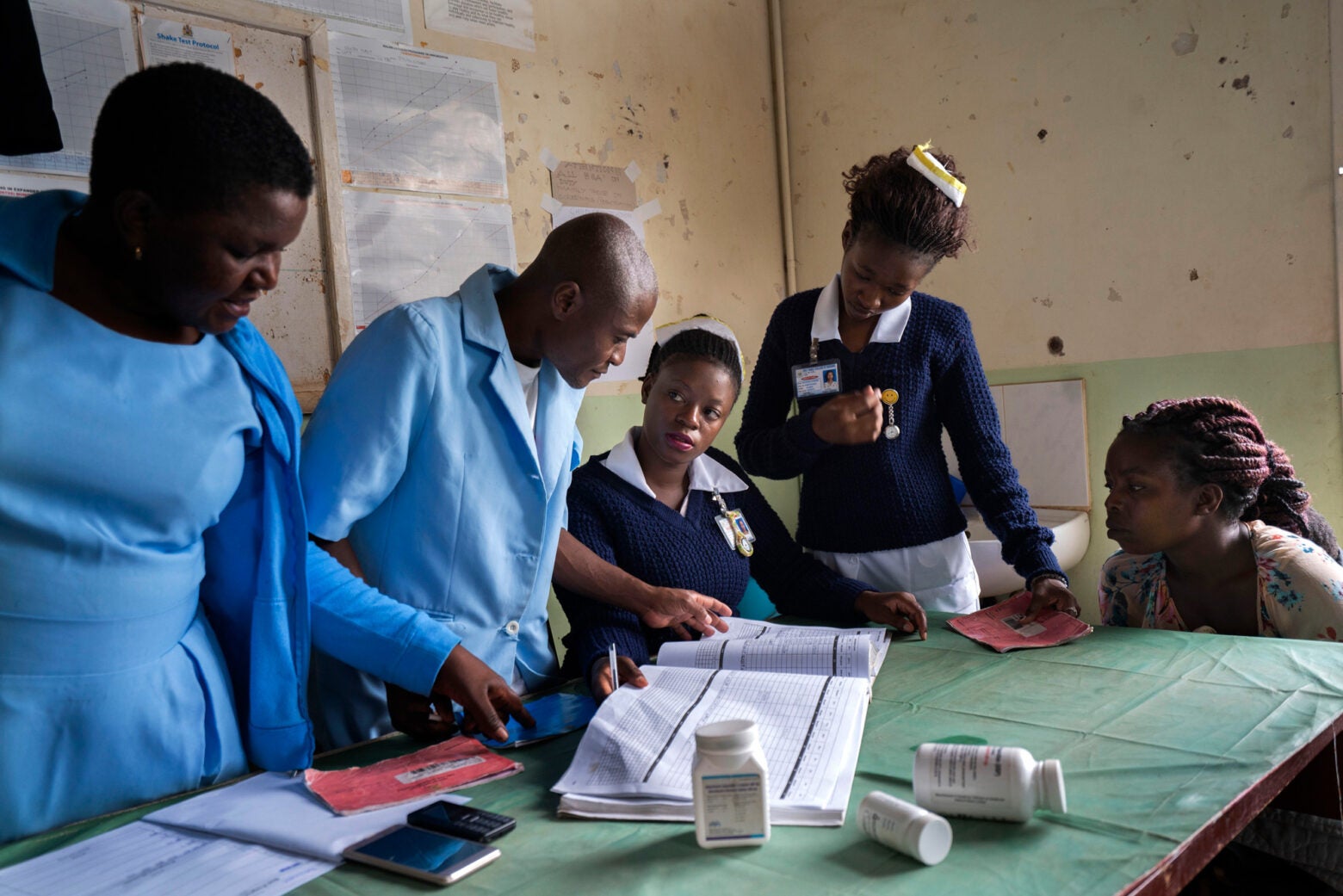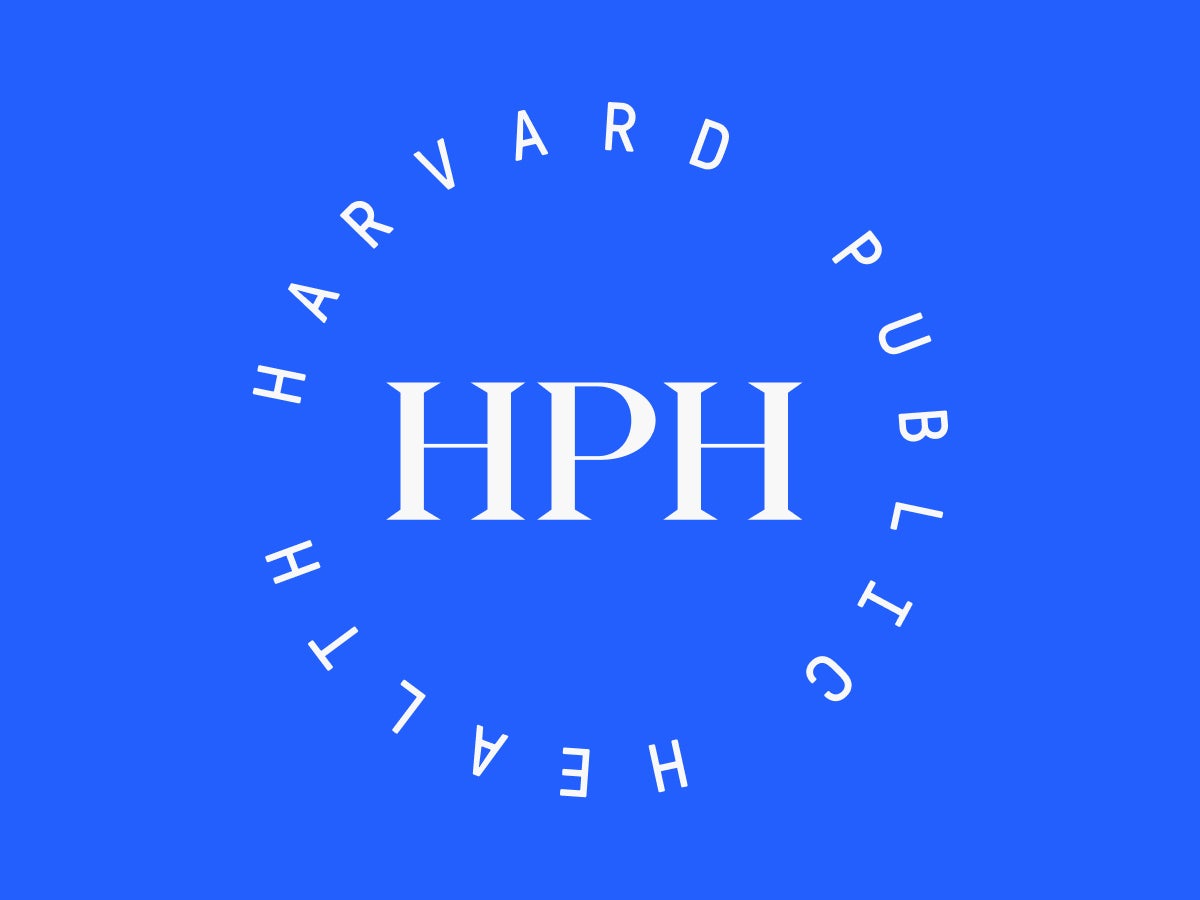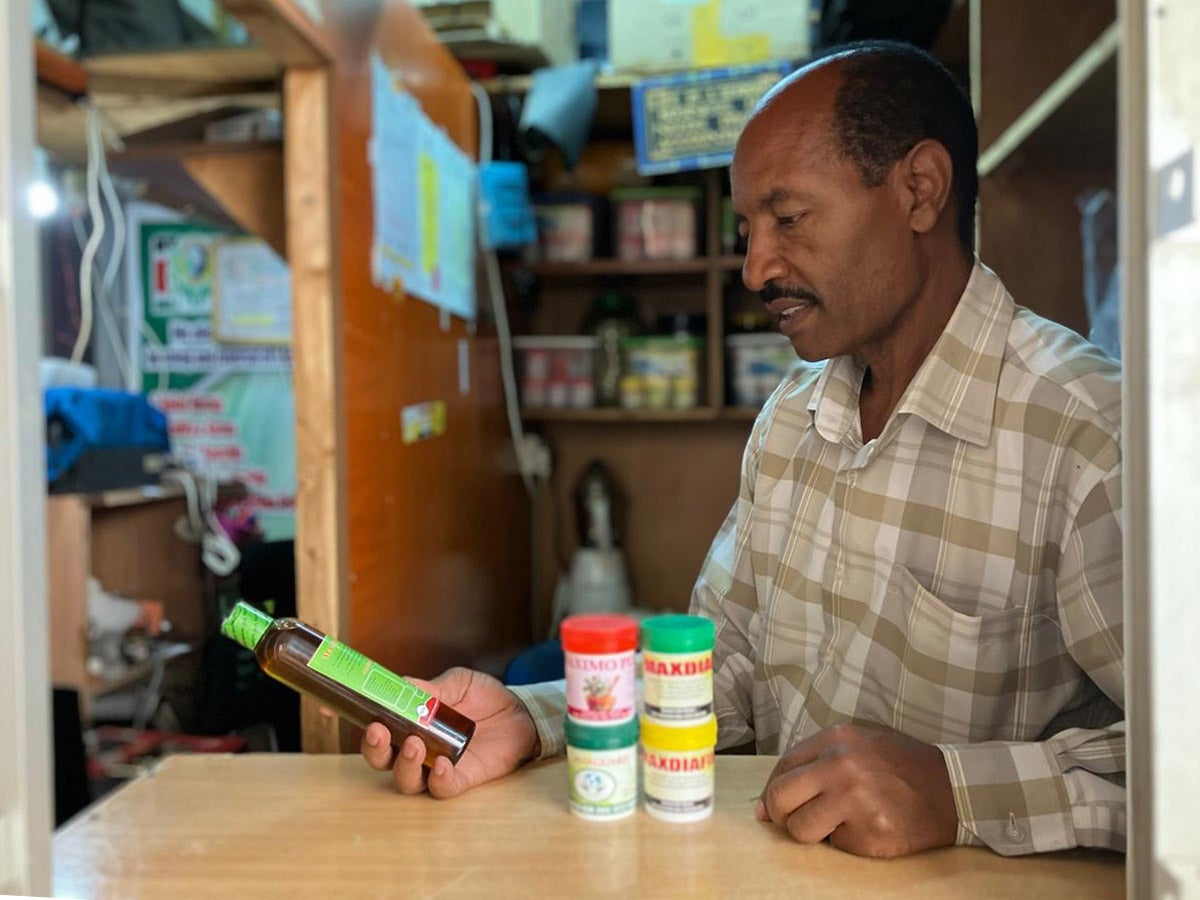
Feature
It took decades to get a malaria vaccine. Now comes the hard part.
Helene Akono’s twins were the first babies in Cameroon to receive their malaria vaccines last winter, when the West African nation launched its nationwide immunization program.
The mother of four took the morning off of work to bring her children for their shots at a health clinic not far from the capital, Yaoundé. She knew the value of the jab: The whole family had suffered from the stress and cost of treating malaria in one of her older children, who was hospitalized for the disease.
Malaria is a global killer, and its mortality figures are highest in Africa. African children under age five made up more than three-quarters of the 608,000 malaria deaths worldwide in 2022, according to the World Health Organization (WHO). Parents like Akono have long taken measures to mitigate their children’s risk of catching malaria—clearing away standing water and encircling sleeping children with bed nets are two common practices—but for many scientists and even parents, a vaccine has long been the dream.
Sign up for Harvard Public Health
Delivered to your inbox weekly.
After more than 60 years of research on the topic, access to a promising multi-dose malaria vaccine is rolling out across Africa. The WHO recommends two types of vaccines, one developed by GSK and another by the University of Oxford. A vaccination pilot program in Ghana, Kenya, and Malawi that began in 2019 has had impressive results: More than two million children received more than eight million doses of one vaccine over four years; severe cases of malaria across the pilot sites dropped by 30 percent, and overall mortality in the age group of the pilot dropped 13 percent.
In January, Cameroon became the first country to launch a national vaccination campaign, and at least 20 more countries in sub-Saharan Africa are expected to do the same before the year is out. Less than two weeks ago, the Central African Republic received its first doses.
WHO officials view the vaccines as a critical tool for reducing malaria incidence and mortality by 90 percent by 2030—a goal laid out by the Global Technical Strategy for Malaria in 2015. Experts also expect the vaccine to reduce hospitalizations and, with them, the financial burden illness can impose on families.
“I know we still have to continue to sleep under bed nets but this [malaria vaccine] is a relief for me as a parent that my children are not left unprotected.”
Helene Akono, cameroonian mother of four
But there are myriad challenges at the front line, such as reaching remote communities, communicating effectively with parents and the public, and ensuring that other prevention measures continue. The multi-dose nature of the vaccine can be yet another challenge: The first three doses must be delivered over 12 weeks, with a fourth dose delivered 12 months later for full immunity. Especially for people in rural areas, so many trips to a health center can become difficult.
The heat is a challenge, too. The vaccines are temperature-sensitive and require storage between 2°C and 8°C (about 36°F-46°F), which creates a logistical challenge in hot and remote regions.
Solar-powered refrigerators are helping solve this problem. In collaboration with the United Nations, Haier Biomedical is supplying Cameroon with refrigerators designed for extreme conditions, capable of maintaining the required temperature range for up to five days without electricity. The Africa Centers for Disease Control and Prevention is also providing vaccine carriers, cold boxes, temperature monitoring devices, and other equipment.

Health officials in the Malawi village of Migowi prepare to administer the world's first vaccine against malaria in a pilot program in 2020.
AP Photo / Jerome Delay
Getting parents on board
One challenge is delivering reliable information about the vaccines to parents who must decide whether their children should receive the jabs. Campaigns on social media, text messaging, and conversations with trusted community members are helping public health advocates expand their reach beyond traditional mass media.
In Cameroon, the government enlisted community organizations and international NGOs to help carry the messages. Mbianke Livancliff, a public health advocate with an NGO, joined influencers including journalists who were educating followers about the vaccine and directing them to reliable sources for information. He also helped train other community workers to answer parents’ questions. He thinks the experience of COVID-19 has made communities more engaged with communications campaigns. “We are seeing parents asking us more questions than before on various aspects of the vaccine,” he says.
He and other health educators explain that the vaccine saves lives, reduces symptoms, and can lessen treatment expenses. Cameroon subsidizes basic malaria treatment (and guarantees it free of charge for children under five), but severe cases can require hospitalization—sometimes multiple times, and each stay could cost families more than a month’s wages.
They also encourage people to continue with existing malaria prevention measures, even after vaccination. The vaccines were studied in combination with ongoing use of prevention tools such as long-lasting insecticide-treated nets, indoor residual spraying with insecticides, preventive treatment for infants and during pregnancy, and prompt diagnostic testing and treatment of confirmed cases.
“We actually monitored whether or not there was inadvertently a reduction in any of the other interventions” during the pilot phase, said Kate O’Brien, director of the WHO’s Department of Immunization, Vaccines and Biologicals. “There weren’t. . . . That was largely because of continuous communication and not just during the visits of parents bringing their children for their vaccine, but also through all of the community channels of communication.”
A model for a successful malaria vaccine launch
The malaria vaccine launch in Cameroon has become a learning opportunity for other African countries. The WHO facilitated a workshop for African public health officials to find out how Cameroon supported a full-scale national rollout by securing vaccine doses, planning for the logistics of its delivery, and promoting the vaccine effectively in French- and English-speaking regions of the country. The popularity of these sessions prompted a similar initiative later in Ghana.
But some countries are choosing a more gradual approach. Nigeria, which accounts for about 27 percent of global malaria cases and more than 31 percent of deaths, is starting with two states before expanding it nationwide. Muhammad Ali Pate, the coordinating minister of health and social welfare, says the government wants to improve collaboration between sectors before rolling out nationally.
Akono, meanwhile, is confident that the shots received so far will ensure that she does not lose a child to the deadly disease. “I know we still have to continue to sleep under bed nets but this [malaria vaccine] is a relief for me as a parent that my children are not left unprotected,” she says.
Lead image: Residents of the Malawi village of Tomali wait to have their young children become test subjects for the world’s first vaccine against malaria in a pilot program. (Jerome Delay / AP Photo)
Republish this article
<p>Multiple doses, remote communities, and heat are all obstacles on the front line.</p>
<p>Written by Paul Adepoju</p>
<p>This <a rel="canonical" href="https://harvardpublichealth.org/global-health/the-malaria-vaccine-is-ready-for-africa-now-comes-the-hard-part/">article</a> originally appeared in<a href="https://harvardpublichealth.org/">Harvard Public Health magazine</a>. Subscribe to their <a href="https://harvardpublichealth.org/subscribe/">newsletter</a>.</p>
<p class="has-drop-cap">Helene Akono’s twins were the first babies in Cameroon to receive their malaria vaccines last winter, when the West African nation launched its nationwide immunization program.</p>
<p>The mother of four took the morning off of work to bring her children for their shots at a health clinic not far from the capital, Yaoundé. She knew the value of the jab: The whole family had suffered from the stress and cost of treating malaria in one of her older children, who was hospitalized for the disease.</p>
<p>Malaria is a global killer, and its mortality figures are highest in Africa. African children under age five made up more than three-quarters of the 608,000 malaria deaths worldwide in 2022, according to the World Health Organization (WHO). Parents like Akono have long taken measures to mitigate their children’s risk of catching malaria—clearing away standing water and encircling sleeping children with bed nets are two common practices—but for many scientists and even parents, a vaccine has long been the dream.</p>
<p>After more than <a href="https://tropmedhealth.biomedcentral.com/articles/10.1186/s41182-023-00516-w">60 years</a> of research on the topic, access to a promising multi-dose malaria vaccine is rolling out across Africa. The WHO recommends two types of vaccines, one developed by GSK and another by the University of Oxford. A vaccination pilot program in Ghana, Kenya, and Malawi that began in 2019 has had impressive results: More than two million children received more than eight million doses of one vaccine over four years; severe cases of malaria across the pilot sites dropped by 30 percent, and overall mortality in the age group of the pilot dropped 13 percent.</p>
<p>In January, Cameroon became the first country to launch a national vaccination campaign, and at least 20 more countries in sub-Saharan Africa are expected to do the same before the year is out. Less than two weeks ago, the Central African Republic received its first doses.</p>
<p>WHO officials view the vaccines as a critical tool for reducing malaria incidence and mortality by 90 percent by 2030—a goal laid out by the <a href="https://www.who.int/docs/default-source/documents/global-technical-strategy-for-malaria-2016-2030.pdf" target="_blank" rel="noreferrer noopener">Global Technical Strategy for Malaria</a> in 2015. Experts also expect the vaccine to reduce hospitalizations and, with them, the financial burden illness can impose on families.</p>
<figure class="wp-block-pullquote"><blockquote><p>“I know we still have to continue to sleep under bed nets but this [malaria vaccine] is a relief for me as a parent that my children are not left unprotected.”</p><cite>Helene Akono, cameroonian mother of four</cite></blockquote></figure>
<p>But there are myriad challenges at the front line, such as reaching remote communities, communicating effectively with parents and the public, and ensuring that other prevention measures continue. The multi-dose nature of the vaccine can be yet another challenge: The first three doses must be delivered over 12 weeks, with a fourth dose delivered 12 months later for full immunity. Especially for people in rural areas, so many trips to a health center can become difficult.</p>
<p>The heat is a challenge, too. The vaccines are temperature-sensitive and <a href="https://www.pharmaceutical-technology.com/news/malaria-vaccines-must-beat-logistics-issues-for-efficient-access/?cf-view" target="_blank" rel="noreferrer noopener">require</a> storage between 2°C and 8°C (about 36°F-46°F), which creates a logistical challenge in hot and remote regions.</p>
<p>Solar-powered refrigerators are helping solve this problem. In collaboration with the United Nations, Haier Biomedical is supplying Cameroon with refrigerators designed for extreme conditions, capable of maintaining the required temperature range for up to five days without electricity. The Africa Centers for Disease Control and Prevention is also providing vaccine carriers, cold boxes, temperature monitoring devices, and other equipment.</p>
<h2 class="wp-block-heading" id="h-getting-parents-on-board">Getting parents on board</h2>
<p>One challenge is delivering reliable information about the vaccines to parents who must decide whether their children should receive the jabs. Campaigns on social media, text messaging, and conversations with trusted community members are helping public health advocates expand their reach beyond traditional mass media.</p>
<p>In Cameroon, the government enlisted community organizations and international NGOs to help carry the messages. Mbianke Livancliff, a public health advocate with an NGO, joined influencers including journalists who were educating followers about the vaccine and directing them to reliable sources for information. He also helped train other community workers to answer parents’ questions. He thinks the experience of COVID-19 has made communities more engaged with communications campaigns. “We are seeing parents asking us more questions than before on various aspects of the vaccine,” he says.</p>
<p>He and other health educators explain that the vaccine saves lives, reduces symptoms, and can lessen treatment expenses. Cameroon subsidizes basic malaria treatment (and guarantees it free of charge for children under five), but severe cases can require hospitalization—sometimes multiple times, and each stay could cost families more than a month’s wages.</p>
<p>They also encourage people to continue with existing malaria prevention measures, even after vaccination. The vaccines were studied in combination with ongoing use of prevention tools such as long-lasting insecticide-treated nets, indoor residual spraying with insecticides, preventive treatment for infants and during pregnancy, and prompt diagnostic testing and treatment of confirmed cases.</p>
<p>“We actually monitored whether or not there was inadvertently a reduction in any of the other interventions” during the pilot phase, said Kate O’Brien, director of the WHO's Department of Immunization, Vaccines and Biologicals. “There weren’t. . . . That was largely because of continuous communication and not just during the visits of parents bringing their children for their vaccine, but also through all of the community channels of communication.”</p>
<h2 class="wp-block-heading" id="h-a-model-for-a-successful-malaria-vaccine-launch">A model for a successful malaria vaccine launch</h2>
<p>The malaria vaccine launch in Cameroon has become a learning opportunity for other African countries. The WHO facilitated a workshop for African public health officials to find out how Cameroon supported a full-scale national rollout by securing vaccine doses, planning for the logistics of its delivery, and promoting the vaccine effectively in French- and English-speaking regions of the country. The popularity of these sessions prompted a similar initiative later in Ghana.</p>
<p>But some countries are choosing a more gradual approach. Nigeria, which accounts for about 27 percent of global malaria cases and more than 31 percent of deaths, is starting with two states before expanding it nationwide. Muhammad Ali Pate, the coordinating minister of health and social welfare, says the government wants to improve collaboration between sectors before rolling out nationally.</p>
<p class=" t-has-endmark t-has-endmark">Akono, meanwhile, is confident that the shots received so far will ensure that she does not lose a child to the deadly disease. “I know we still have to continue to sleep under bed nets but this [malaria vaccine] is a relief for me as a parent that my children are not left unprotected,” she says.</p>
<script async src="https://www.googletagmanager.com/gtag/js?id=G-S1L5BS4DJN"></script>
<script>
window.dataLayer = window.dataLayer || [];
if (typeof gtag !== "function") {function gtag(){dataLayer.push(arguments);}}
gtag('js', new Date());
gtag('config', 'G-S1L5BS4DJN');
</script>
Republishing guidelines
We’re happy to know you’re interested in republishing one of our stories. Please follow the guidelines below, adapted from other sites, primarily ProPublica’s Steal Our Stories guidelines (we didn’t steal all of its republishing guidelines, but we stole a lot of them). We also borrowed from Undark and KFF Health News.
Timeframe: Most stories and opinion pieces on our site can be republished within 90 days of posting. An article is available for republishing if our “Republish” button appears next to the story. We follow the Creative Commons noncommercial no-derivatives license.
When republishing a Harvard Public Health story, please follow these rules and use the required acknowledgments:
- Do not edit our stories, except to reflect changes in time (for instance, “last week” may replace “yesterday”), make style updates (we use serial commas; you may choose not to), and location (we spell out state names; you may choose not to).
- Include the author’s byline.
- Include text at the top of the story that says, “This article was originally published by Harvard Public Health. You must link the words “Harvard Public Health” to the story’s original/canonical URL.
- You must preserve the links in our stories, including our newsletter sign-up language and link.
- You must use our analytics tag: a single pixel and a snippet of HTML code that allows us to monitor our story’s traffic on your site. If you utilize our “Republish” link, the code will be automatically appended at the end of the article. It occupies minimal space and will be enclosed within a standard <script> tag.
- You must set the canonical link to the original Harvard Public Health URL or otherwise ensure that canonical tags are properly implemented to indicate that HPH is the original source of the content. For more information about canonical metadata, click here.
Packaging: Feel free to use our headline and deck or to craft your own headlines, subheads, and other material.
Art: You may republish editorial cartoons and photographs on stories with the “Republish” button. For illustrations or articles without the “Republish” button, please reach out to republishing@hsph.harvard.edu.
Exceptions: Stories that do not include a Republish button are either exclusive to us or governed by another collaborative agreement. Please reach out directly to the author, photographer, illustrator, or other named contributor for permission to reprint work that does not include our Republish button. Please do the same for stories published more than 90 days previously. If you have any questions, contact us at republishing@hsph.harvard.edu.
Translations: If you would like to translate our story into another language, please contact us first at republishing@hsph.harvard.edu.
Ads: It’s okay to put our stories on pages with ads, but not ads specifically sold against our stories. You can’t state or imply that donations to your organization support Harvard Public Health.
Responsibilities and restrictions: You have no rights to sell, license, syndicate, or otherwise represent yourself as the authorized owner of our material to any third parties. This means that you cannot actively publish or submit our work for syndication to third-party platforms or apps like Apple News or Google News. Harvard Public Health recognizes that publishers cannot fully control when certain third parties aggregate or crawl content from publishers’ own sites.
You may not republish our material wholesale or automatically; you need to select stories to be republished individually.
You may not use our work to populate a website designed to improve rankings on search engines or solely to gain revenue from network-based advertisements.
Any website on which our stories appear must include a prominent and effective way to contact the editorial team at the publication.
Social media: If your publication shares republished stories on social media, we welcome a tag. We are @PublicHealthMag on X, Threads, and Instagram, and Harvard Public Health magazine on Facebook and LinkedIn.
Questions: If you have other questions, email us at republishing@hsph.harvard.edu.


